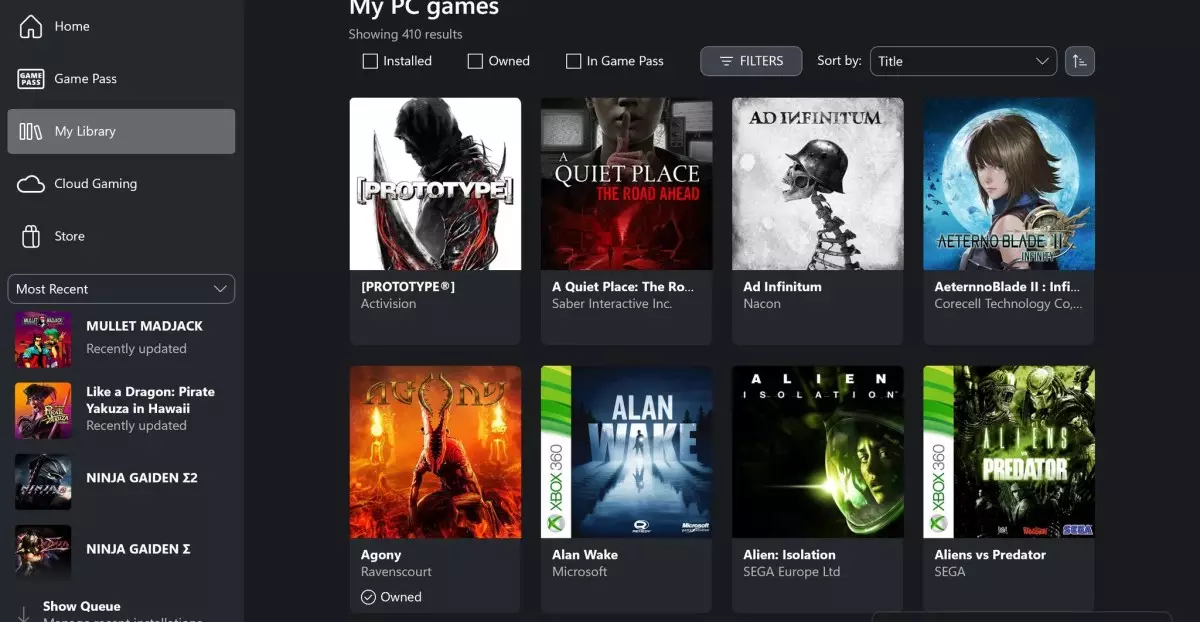In today’s fast-paced technological environment, gaming is no longer just a pastime; it has morphed into a multifaceted industry that combines immersive experiences with community interaction. As games evolve, so too must the platforms that host them. Microsoft, a steadfast titan in the tech arena, is taking significant strides towards unifying its gaming and operating systems through the Xbox and Windows integration. This initiative isn’t merely a forward-thinking maneuver, but a necessary evolution in an era that demands cross-platform capabilities and user-friendly ecosystems.
Rumblings of Change in the Xbox App
Recent developments within the Xbox PC app signal a pivotal change that goes beyond mere updates. The appearance of Xbox console games in the app’s library seems more than just a glitch; it’s indicative of a larger strategy that aims to blur the lines between console and PC gaming. This integration supports the notion that Microsoft is keen on offering a seamless experience for gamers across devices. Owners of historical titles like “Alan Wake” for Xbox 360 can now see these games listed alongside their PC counterparts, a hint that Microsoft envisions a comprehensive gaming library irrespective of platform.
This attempt to centralize game accessibility underscores Microsoft’s ambition to create a more cohesive gaming ecosystem. In an age where digital ownership is paramount, the ability to see console games in the same app as PC games removes the fragmentation that has traditionally defined the gaming experience.
Project Kennan and the Handheld Future
Adding another layer to this vision is Microsoft’s collaboration with Asus on Project Kennan—an ambitious handheld gaming device that blends the best features of Xbox and Windows. This pursuit is not just about portability; it’s about delivering an integrated gameplay experience that caters to both console gamers and PC enthusiasts. The push to develop handheld devices reflects a growing trend where gamers increasingly seek flexibility in how they engage with their favorites.
Moreover, as competitors innovate with their own handheld devices, Microsoft’s venture aims to reclaim market share and bolster its position against platforms like SteamOS. In the face of rising competition, Microsoft appears resolute in bringing its gaming strategy into sharper focus, emphasizing not only hardware evolution but also software robustness.
Vision for a Universal Library
At the heart of Microsoft’s integration strategy lies the aspiration for a universal library that encompasses both Xbox and PC games. Sources within the company have hinted at efforts to enable visibility for games from other platforms like Steam and the Epic Games Store within the Xbox PC app. Such a move could revolutionize how players access content, making it impractical for developers to ignore this comprehensive ecosystem.
If successful, this unification can serve as a refreshing antidote to the disjointed experiences that gamers currently face when juggling multiple platforms and stores. The notion of having all games visible in a single interface simplifies the user experience immensely, and it could stimulate a surge in game purchases by players eager to partake in both Windows and Xbox offerings.
Cloud Gaming as a Potential Game-Changer
However, many questions loom over this ambitious initiative, particularly concerning the feasibility of playing console games on PCs. The integration of cloud technology could present a transformative solution. Rather than relying solely on emulation—an often clunky and inconsistent method—leveraging cloud infrastructure might enable players to access their entire library without the need for additional hardware. This would mark a pivotal shift in the gaming industry, offering possibilities previously viewed as unrealistic.
Cloud gaming not only provides a means of integrating and accessing older titles but also positions Microsoft advantageously against its competition. The realization of this vision hinges on Microsoft’s ability to effectively harness its resources and innovations in cloud technology, potentially setting new industry standards.
Microsoft’s Defining Moment
As Microsoft continues to navigate this complex landscape of gaming ecosystems, it finds itself at a defining moment. The convergence of Xbox and Windows, propelled by factors like Project Kennan and cloud capabilities, signals a future where gaming isn’t just confined to specific devices. Instead, it embraces a world where access and playability are paramount.
In a market that leans increasingly toward interconnected gameplay experiences, Microsoft’s movements are more than just strategic; they are essential. Delivering on this promise could not only reshape user expectations but also redefine how gaming is experienced, heralding a new era for both casual players and dedicated enthusiasts alike. Microsoft’s commitment to intertwining Xbox and Windows offers an exhilarating glimpse into the future of digital gaming, elevating its user experiences to unprecedented heights.

